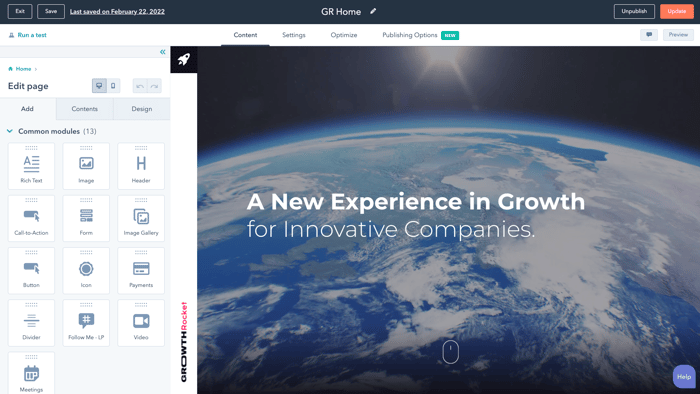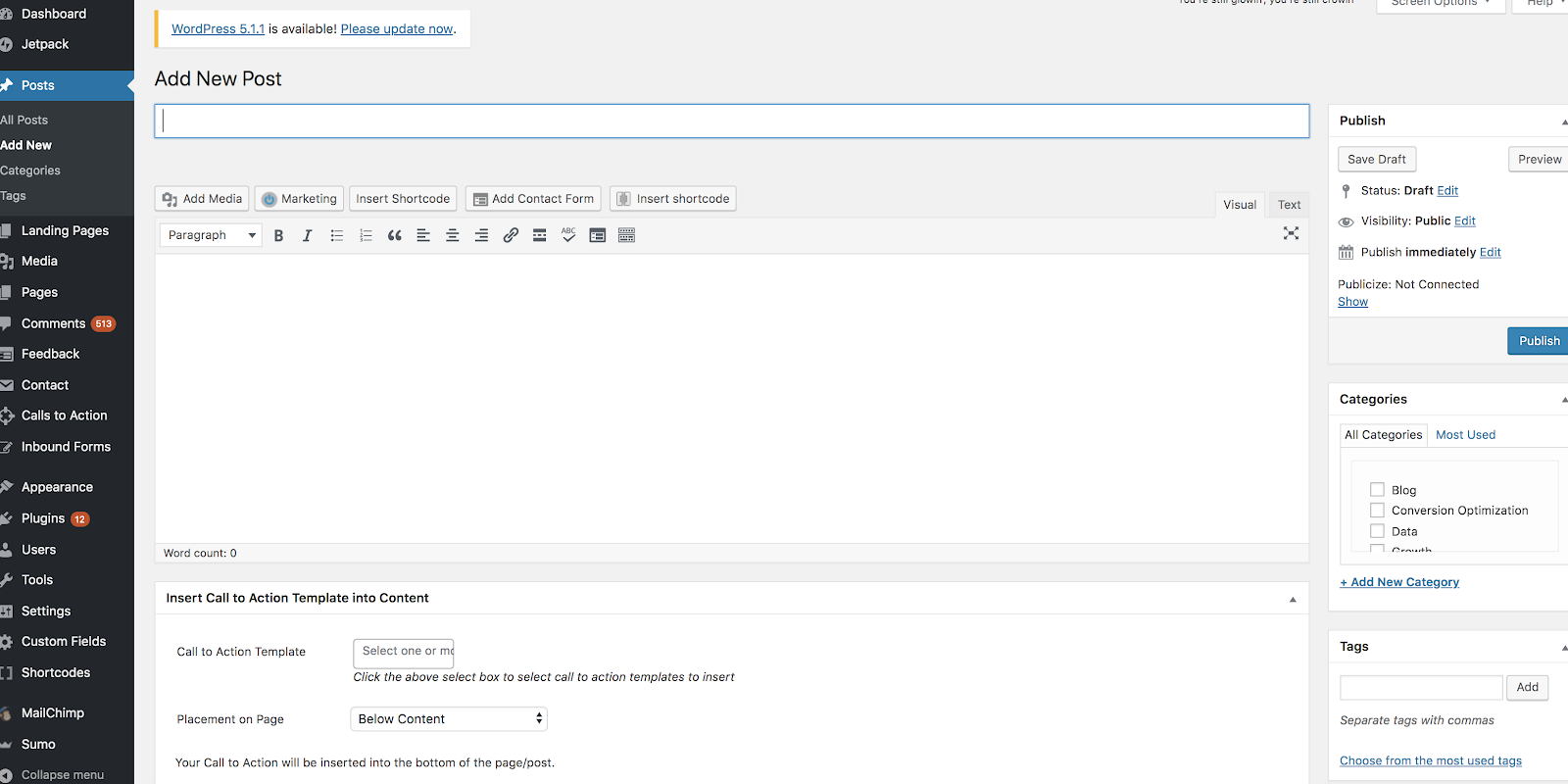The 10 Best Content Management Software Tools in 2023
Running a website requires input and strategy from your whole business team (developers/engineers, marketers/UX, sales, etc.). Using Content Management Software (or CMS) helps you deliver a great product to your customers while granting easy code access for your developers/engineers.
Without a good integration between your content management software and your other systems, something as simple as successfully sending a follow-up email after a form submission can become a massive time suck.
Let’s explore the characteristics you need for any content management software tool and the ten best content management software tools for marketers. Feel free to use the following jump links to navigate or just scroll.
Characteristics of the Best Content Management Software Tools
Here are some features marketers should feel good about in a content management software tool.
1. A powerful, flexible editor.
As marketers, we need to be able to do things like quickly produce a landing page for a Facebook campaign, make simple layout changes to a page (like adding a column or testimonials module), and easily edit the content on existing pages (like changing some of the text of your homepage to promote your upcoming annual conference).
A powerful WYSIWYG (“what you see is what you get”) editor is critical, so if you can, ensure you’re comfortable making changes within the content management software tool.
2. The ability to test.
It’s crucial you’re able to understand what’s working, so you can do more of the good stuff. You need to be able to efficiently run tests on outcomes for different headlines, layouts, and more. It’s especially critical when doing something like a paid campaign, where maximizing results is tied directly to spending.
3. The opportunity for increased collaboration.
Chances are, you have a team of people working on one website.
You may have a developer who works on complex design pieces and integrations, a marketer who runs the day-to-day and manages campaigns, and content creators who write blog posts.
The ability to collaborate within the content management software tool and set permissions makes life a lot easier — and ensures issues don’t arise like your social manager accidentally overwriting the developers’ code.
4. Accessibility to support.
Oftentimes, your developer can fill this need — but that can get expensive if you’re paying by the hour. It’s maybe not mission critical, but it sure is nice to have a support team you can call for help when you need it, especially when it’s halting your ability to launch a campaign.
5. Ability to integrate with the rest of your tools.
Last but probably most importantly, you need your content management software to integrate with the rest of your tech stack. Generally, the best choices here will be open platforms or all-in-one solutions.
Ideally, it should at least be able to integrate forms with a mailing tool (for lead/ mailing list collection), as well as your CRM or some kind of database, so you can personalize content. Additionally, you’ll want to integrate with your CRM to customize pages and add pages quickly and easily.
Now that we’ve explored five critical components of any content management software tool let’s explore our ten favorites.
1. CMS Hub
CMS Hub by HubSpot is more than just a content management software tool since it lives on your CRM.
HubSpot’s content management software tool has nice features like A/B testing, but it’s particularly powerful regarding features like personalized content and smart content. If you’re using HubSpot’s marketing platform, it also works seamlessly with forms, your email list, and database management.
For instance, you want a list of everyone in your database who visited your pricing page in the last 30 days. This is incredibly easy to do with HubSpot’s content management software and CRM.
It also scores well on the design side — like any content management software tool, it offers predesigned templates, a developer platform, and a network of partners certified in the content management software.
There are also some great out-of-the-box features designed to help with content creation — like the ability to natively host video and add forms and calls-to-action in the video using the native editor, along with video analytics and a YouTube analytics integration.
Some of the features marketers will love on a platform level are the ability to partition content, so it’s easier for teams to work together. Additionally, you can publish content behind passwords and easily personalize content. Best of all, its high-quality security and hosting take the worry out of the technical side. And, of course, you get top-notch analytics since everything works together.

2. Squarespace
Squarespace offers beautiful out-of-the-box designs with tons of customization options. You can easily download any theme and change colors, fonts, and other design elements. It seems geared more toward the end user than the developer, so most edits are made in a WYSIWYG design editor.
Behind the scenes, they boast high-quality, secure hosting — something that isn’t always top of mind when selecting a content management software tool but probably should be. It also allows for unlimited bandwidth and storage, which isn’t always the case if you’re buying hosting on its own.
It’s also nice to have a support team, and Squarespace has a team that answers support tickets, so you’re not totally on your own or stuck calling a developer for every question. Additionally, it offers incredibly useful help documentation.
Squarespace offers tons of modules and integrations, although you might want to check their built-in integrations to make sure the rest of your tech stack will play well with Squarespace.

3. Wix
Wix has many templates and a free plan that gives you unlimited pages. If you need to get an online presence up and running right away, it’s a great choice.
They also have paid plans that give you additional features, including increased storage, the ability to add forms, a calendar, and access to VIP Support.
It’s important to note Wix is a bit tougher to customize — they don’t give access to CSS, although they do say you can “take full control of your website’s functionality with JavaScript and Wix Code API’s.”
Additionally, inserting third-party code (like tracking code) can be challenging, so eventually, as your business grows, you or your developer may want something with a bit more customization capability.

4. WordPress
And next, we come to WordPress. WordPress is everywhere — it’s a popular platform and has a large ecosystem of developers, designers, and plenty of others who are familiar with it.
The content management software tool itself is free, although you’ll need to pay for hosting and probably a template at the very least, and more likely a developer or designer to help you get it up and running.
Your ease of use here will likely depend on how it’s set up and which theme you use — some have simple WYSIWYG editors, while others are more complex. You’ll want to discuss this with your developer since once it’s built, there isn’t much you can change.
It’s also incredibly customizable. There are a ton of plugins and add-ons you can use to help with anything from SEO, speed, automatic image resizing, and more.
WordPress also implements automatic background updates that help reduce any security issues that may arise.
On the hosting side, we recommend a hosting platform specializing in WordPress, like WP Engine, since the support teams are well-versed in WordPress — which means they can help with questions and offer additional resources. Using a popular theme with plenty of existing help documentation or a support team can make a huge difference.
It’s important to note the openness of the platform results in a vulnerability to hacking (this is another reason to get a good host). Be aware that addressing security should be part of the initial plan and not be an afterthought to design since security breaches are hard to fix and require technical expertise.
However, WordPress addresses this issue by having frequent, automatic background updates. Security issues are usually because hackers prey on old software. With automatic background updates, this is a significantly reduced issue.
 5. Joomla
5. Joomla
Joomla is great because it has a lot of built-in functionality that lets you fully customize your website (over 6,000+ extensions), tinker with SEO settings, easily change languages, and manage your webpages individually.
Unlike WordPress, Joomla doesn’t have automatic background updates. So if you choose to use this software, you will have to take on the responsibility yourself.
With Joomla, you can customize your website fully, but it depends on how much technical knowledge you have when it comes to web-building.
6. Drupal
Drupal is a great choice for developers technically familiar with HTML and CSS. You have complete control over your website, so if you have a team of developers ready to work on your website, this might be the best content management software tool for you.
Drupal also has tens of thousands of Modules and thousands of themes to increase customizability. These modules and themes also give you a lot of freedom, so those with a technical background can take full advantage of these features.
7. Sitecore
What sets Sitecore apart from the other CMS platforms on our list is the ability to reuse content and quickly work on a site across teams using Sitecore Experience Accelerator (SXA). This can speed up the process for developers. Here is what the toolbox looks like.
Sitecore is great if you have a team of experienced developers to fully use the team-building developing features. If you’re on your own or aren’t experienced with coding, you might be better off using a different CMS.
8. Shopify
This is the best option for e-commerce retailers and first-time sellers. Shopify trades in versatility for ease of use and simplicity. If you’ve never created a website before and are still learning the ropes, this is one of the best content management software tools.
Shopify is on the pricier side, with its cheapest plan being $29/month, but you are paying for the ability to create a website with little to no hassle. Another bonus is that all Shopify websites are PCI compliant by default, meaning you can accept payments from Visa, MasterCard, American Express, and Discover.
You won’t have to worry about security as much with Shopify, as the platform regularly conducts automatic background updates, so your website will almost always be up to date.
9. Ghost
Ghost is best for users who want to build a website dedicated to blogging. They have a simple and intuitive interface that lets you quickly publish content to your users. Ghost also makes it easy to offer gated content so you can monetize your blog or other forms of content.
To use Ghost, you must pay for one of their subscription plans. You can try the CMS out for $9/month, but if you want to fully build a website, you must pay at least $25/month (billed yearly).
10. Webflow
Webflow is a visual platform that lets you build websites using its intuitive drag-and-drop tool. It is a tool that is best for people who want something with little to no coding experience required and is low maintenance. Here is an example of what the site editor looks like.
You can try the website for free, but to get full use of the CMS, you will need to pay $23/month (billed yearly).
Getting Started With a Content Management Software Tool
While these are ten popular choices for marketers, many more are out there. The options are endless for content management software tools. Ultimately, you must consider your workflow, your team, and the workflows you have in place to help you make the best decision.
![]()



